Asteroid McCarthy
Some time ago I took an animation of asteroid Randi which he had on his website for some time. Phil Plait replaced him as president of his organization for a short time. Randi asked me to do his asteroid. That led to requests for other skeptics that had asteroids named for them by a rather famous asteroid hunter Jeff Medkeff who died in 2008 at the young age of 40 (maybe 39) of liver cancer. Anyway, one of those requests was for "Swoopy", Robynn McCarthy. The naming citation reads: "(106537) McCarthy = 2000 WB63
Robynn McCarthy (a.k.a. "Swoopy") produces and co-hosts Skepticality, a podcast talk show that promotes science and skeptical thinking. Her sense of humor and accurate reporting have inspired and informed thousands of listeners." She has since left the podcast (with a few exceptions) for additional schooling. She was still with the podcast at the time I took this image back on March 14, 2009. The asteroid was 20.1 magnitude and right beside a magnitude 5.6 star making things difficult. I've included 2 images, one tracking on the orbital elements of the asteroid and one tracking on the stars. Only the latter could be done in color.
There are three other asteroids in the image. Note that asteroids in the main belt like these often have similar motion in a particular area of the sky. This means if you track on the expected motion for that area you can at least partly freeze their motion allowing a gain of one or two magnitudes over a trailed asteroid. In this case, two of the three had almost the same motion as McCarthy while the forth was moving west almost as fast but was also moving north so left a short north trail leaning a bit east. Still, it is much brighter than seen on the trailed image. This is a good trick for those hunting asteroids with mounts capable of this type of tracking (most, unfortunately, can't and one reason I went with the Paramount as it could do this easily (one mouse click to get to the menu needed and one to start the tracking nothing else needed but very good polar alignment and PEC).
Tracking on the asteroid blurred the galaxy near McCarthy rather badly into a fuzzy blob. It is PGC 35162 at 670 million light-years. According to the Minor Planet Center McCarthy was magnitude 20.1; (169812) 2002 QT35 was magnitude 19.0; (209179) 2003 UU150 was magnitude 19.9 and (46014) 2001 CF27 was by far the brightest at magnitude 17.5.
14" LX200R @ f/10, Tracked image 4x5' trailed color image L=4x10' RGB 2x5', STL-11000XM, Paramount ME Color data hit badly by clouds so is weak.
| 
MCARTHY-4X5.jpg

MCARTHY-4X5ID.jpg

MCARTHYLUM4X10rgb2x5.jpg
|
This new nebula, first recognized by amateur astronomer Jay McNeil when trying out a new 3" telescope in 2004 has interested me. It's appearance was short lived as by 2005 it was gone. An amateur photo by Evered Kreimer in 1966 shows it but images taken before and after this date don't. When I finally got the observatory up and running in 2005 it was gone as mentioned. Figuring I likely had 40 years before it would reappear I crossed it off my list but kept hoping it would return. When it came out of the sun's glare in August of 2008 it was back! Since then I've kept watch on it though it seems not to be well followed by the amateur community for some reason.
Images I took in September then again in late October of 2008 showed it had changed somewhat from its previous appearance. This image is taken in February 2010 then lost on my hard drive until recently. Unfortunately my color data was hampered by severe clouds. They dimmed the overall image somewhat but seeing was far better than 2008. This makes comparing the two difficult but it appears there's little change over this period. There appears to be a faint spur coming out of the bottom right of the nebula that is lost in the bright region to its left in the 2008 image but is barely seen. This may be a seeing effect. See the cropped image for the comparison.
McNeil's Nebula is thought to be a brand new star, V1647 Ori, shedding the dust cloud that surrounded it's formation. As the cloud is blown away it allows the light to hit and reflect dust to its north. In this case both the star and nebula become visible at the same time.
Below the nebula are some other very new stars. The group of four red objects below McNeil's nebula are Herbig Haro objects HH24a-d. These are also new stars. In this case they are creating high speed jets out their rotational axes that hit nearby gas and dust. The red comes from hydrogen alpha emissions created by hydrogen gas hit by the jet. Such objects are thought to last only a very few thousand of years being a short phase in the birth of a star.
Further south is another cloud, mostly seen by reflection. It is lit by the light of the T Tauri star HGC 502. These likely are somewhat "older" new stars, being a million years old or so. They are still not on the main sequence and vary in intensity. They often are lighting up the dust and gas that surrounds their birth site. Since they vary in intensity as they get their fusion cores under control as they move onto the main sequence where they will spend most of their lives, the nebula also varies in intensity. Since light travels at a finite speed the star and nebula appear to vary independently of each other. This is due to the light travel times involved due to the geometry of their location and ours.
So where does McNeil's nebula fit in? It is likely lit by an FU Orionis Star. These too are stars still in their infancy that haven't reached the main sequence as yet. They are known for "rapid" brightening of several magnitudes, often staying very bright for years at a time. But "rapid" only in the astronomical sense. They can take only months or decades to brighten. The range is quite great. Since the brightening has always happened when no one is looking both the nebula and star are at full brightness. It should be that they brighten somewhat differently as the light from the star has to travel the length of the nebula and has to then come to us. Thus it should brighten with the parts with the shortest light travel path (star to nebula to earth) being seen lit first. Yet this isn't seen. It could be that the star is hidden behind a curtain of dust so little visible light escapes (its been known for some time in IR light -- the star not the nebula). Then a cloud on our side of the star opens up so we see the star. Its light then illuminates a small part of the dust cloud further out but only that small part that's between us and the star, the rest is still shadowed. If the star really brightened suddenly and the dust was all around it we'd see different parts of it illuminated at different times unless the only dust is nearly on a line between us and the star. Possible but given this whole area is in deep dust I think unlikely. That's about all I can think of. Any other ideas?
Above McNeil's nebula is a somewhat larger reflection nebula, NGC 2064. The huge reflection nebula at the top is M78, probably the brightest reflection nebula known.
Good seeing -- lousy transparency: Lousy seeing -- good transparency. Why do these follow a "corollary" of the Heisenberg Principle?
14" LX200R @ f/10, L=4x10' RG=2x10'x3 B=3x10'x3, STL-11000XM, Paramount ME | 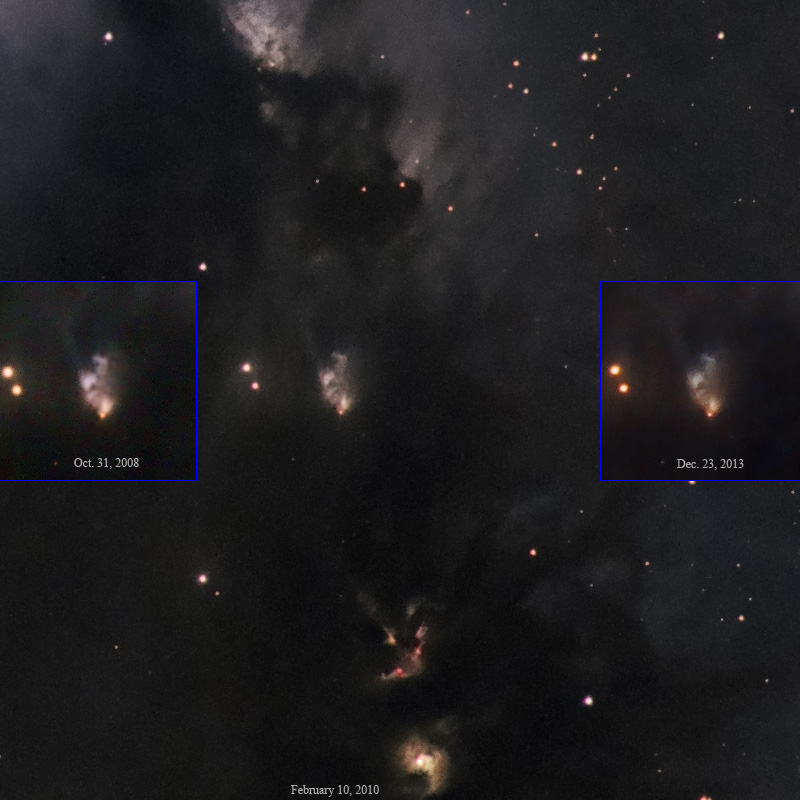
MCNEILS_NEBULA_3_YEAR_COMPARE.JPG
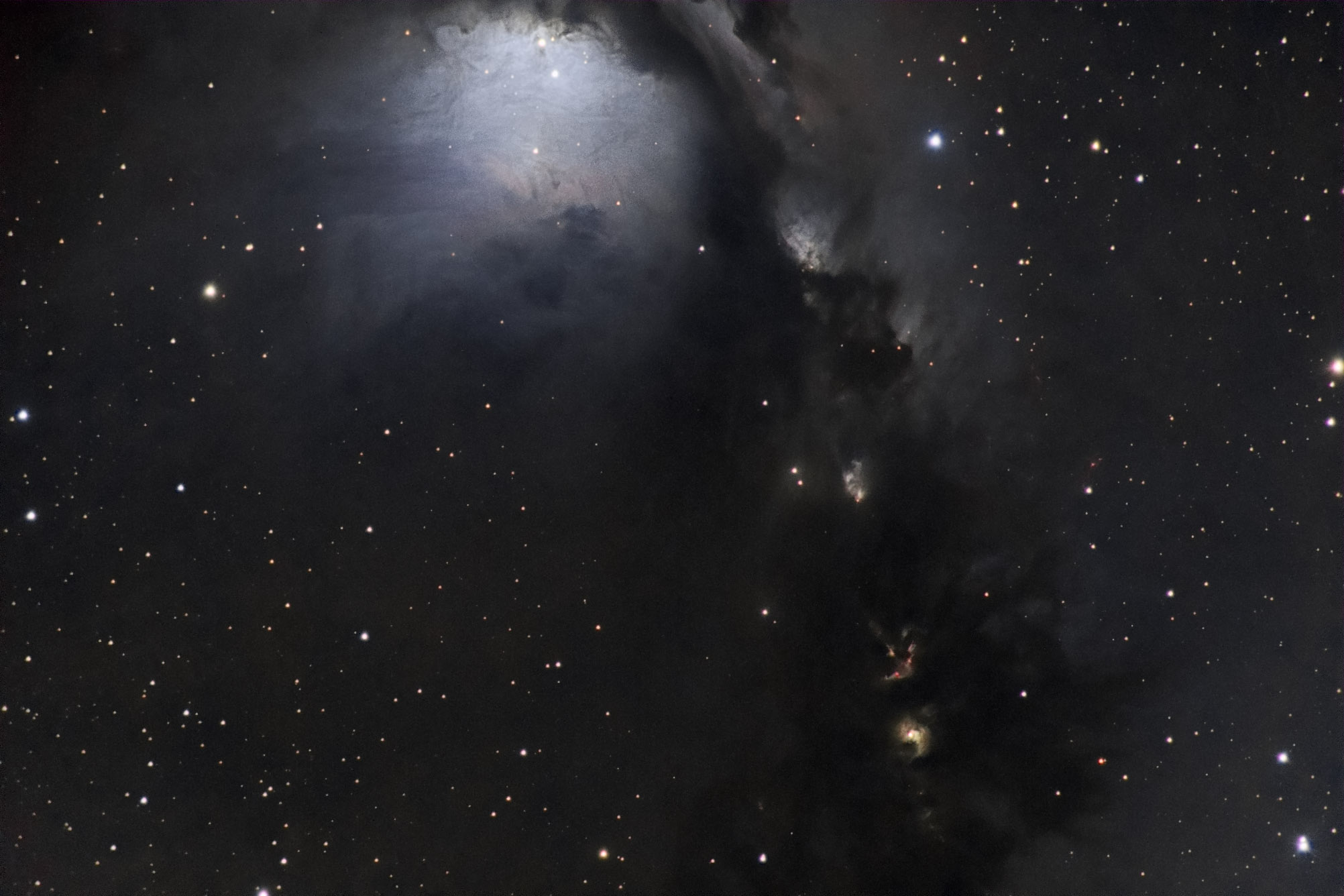
MCNEILS_NEBULA_L4X10RG2X10X3B3X10X3r.jpg
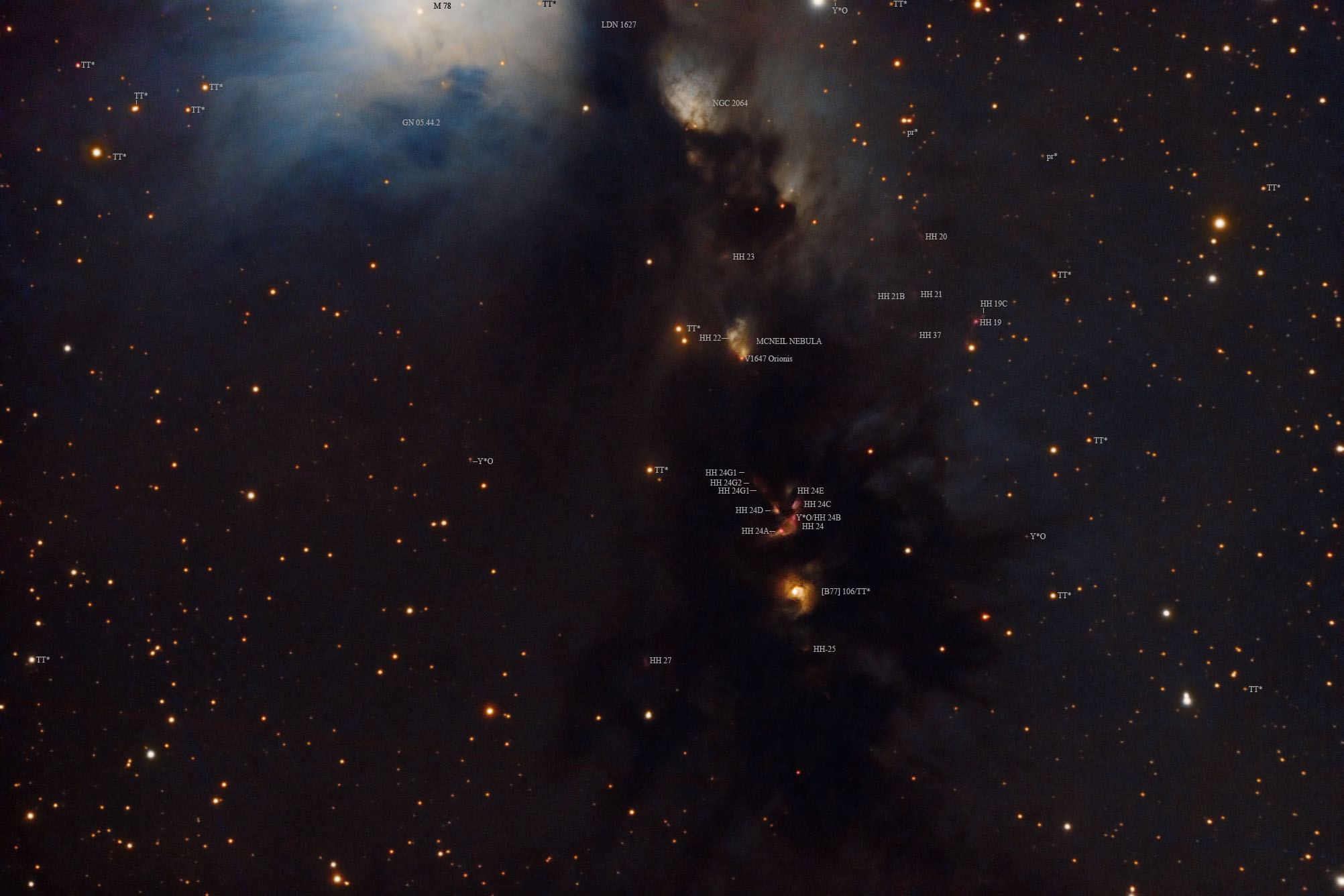
MCNEIL_L6X10RGB3X10ID.JPG
|
Minkowski's Butterfly, M2-9, is an interesting bipolar planetary nebula whose form is the result of two tubular jets created by interaction with its companion star. Most central stars are blue and that is likely the case here but the companion is a much brighter reddish star and that's what dominates. This one is too low in my skies for good seeing at my latitude. At least with the seeing, I had most of 2012. So other images posted on the net are far better as they were taken from more southern latitudes and also areas known for better seeing on average. See: http://www.cloudynights.com/ubbthreads/showflat.php/Cat/1,2,3,4,5,8,10/Number/3996507/Main/3985609 and http://www.pbase.com/jshuder/image/146351218/original for narrowband images without the seeing bloated LRGB stars in mine.
For more info see the HST image at: http://www.spacetelescope.org/images/opo9738a/
The jet is precessing as shown in the Wikipedia image at: http://en.wikipedia.org/wiki/File:M2-9motivo_corradi.gif
Only one galaxy with redshift data is in the image. It is a small round galaxy partly hiding behind a star near the southern edge of my image near the centerline. It is a bit over a half billion light-years distant by redshift light travel time measurement. Southeast of the planetary is the flat disk galaxy 2MFGC 13673. These galaxies from the 2 micron survey don't have to be as flat as those from the optical Flat Galaxy Catalog. There are a few other 2 micron survey galaxies in the field but none even have a magnitude estimate let alone a distance one so I didn't prepare an annotated image.
Conditions were so poor in June I tried many different nights and still only captured one usable blue frame so my color is suspect as even that night was poor compared to some of the other nights I got red and green data. They were only rather bad by comparison. I took over 30 frames to get the 9 barely usable ones.
14" LX200R @ f/10, L=4x10', RG=2x10' B=1x10', STL-11000XM, Paramount ME Related Designations for MINKOWSKISSDSS J012547.03-012218.4, APMUKS(BJ) B012314.23-013754.6, LEDA 073957, SSTSL2 J012547.34-012220.9, ABELL 0194:[D80] 037, ABELL 0194:[NFS85] 104, ABELL 0194:[LGC91] 0116, [BDG98] J012547.4-012221, MINKOWSKIS, BUTTERFLY, SDSS J012547.39-012221.0, | 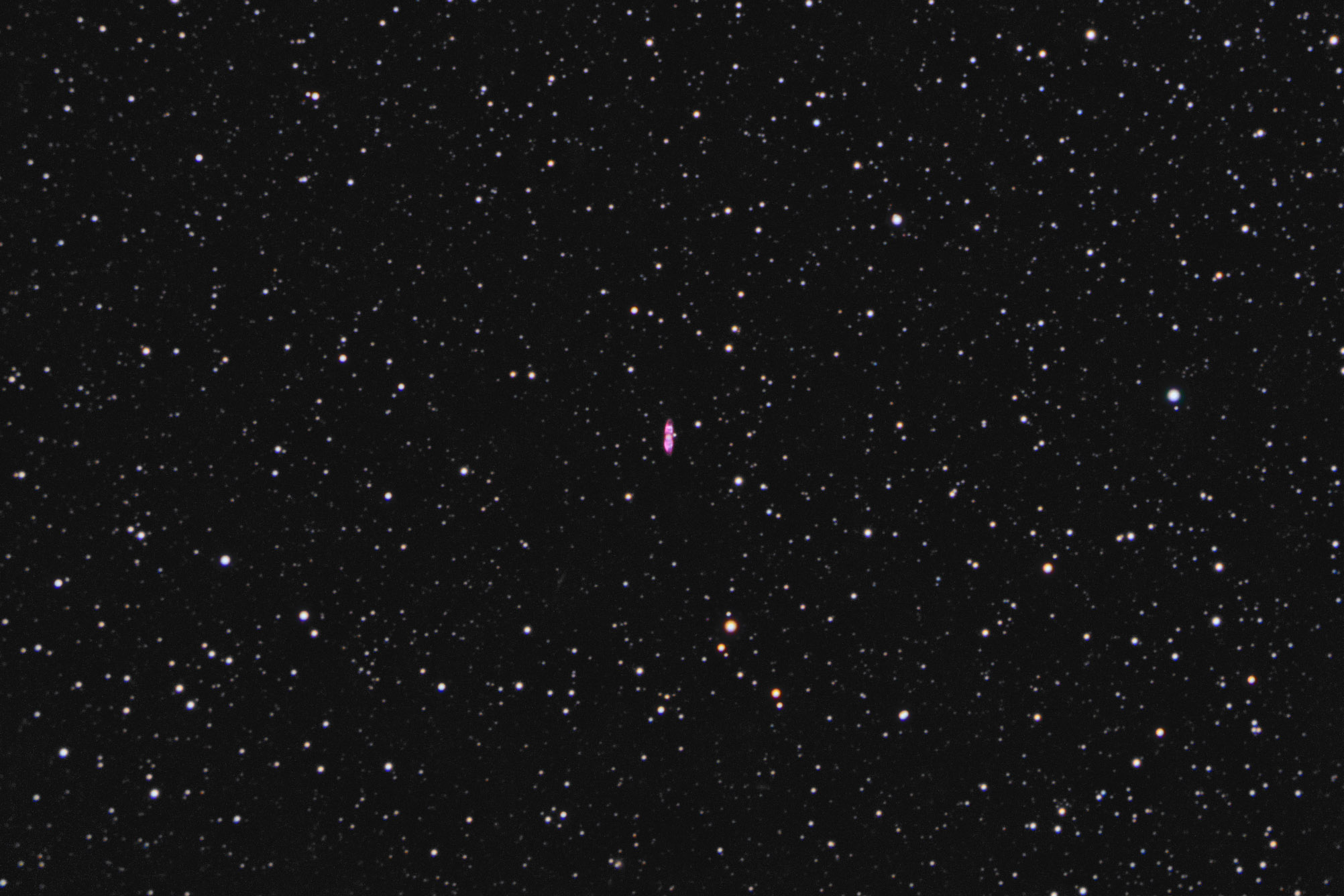
M2-9L4X10RG2X10B1X10.JPG
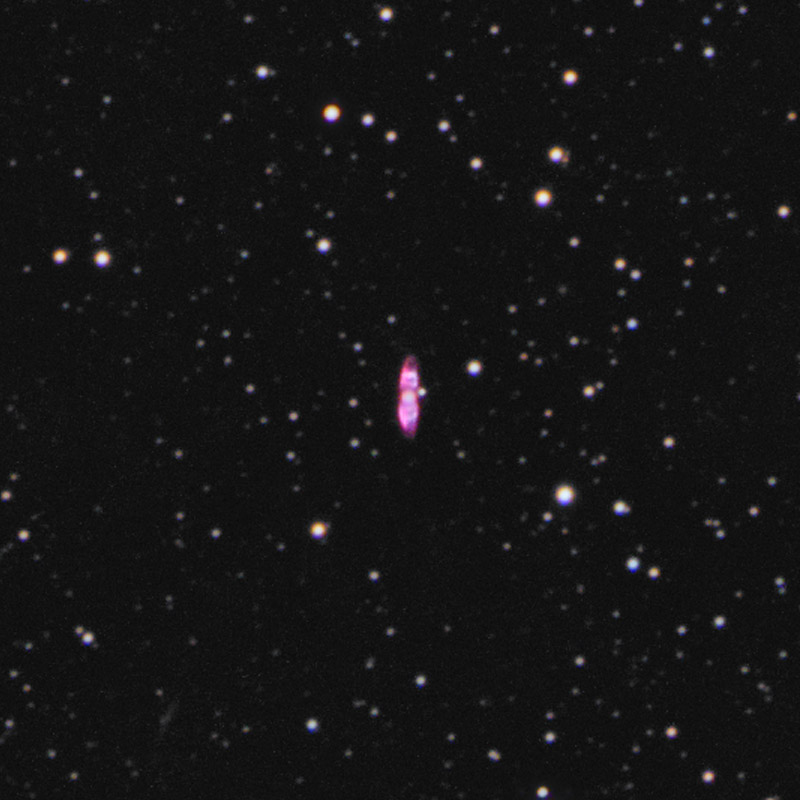
M2-9L4X10RG2X10B1X10CROP150.JPG
|
MRK 0231 is a very active galaxy in Ursa Major a bit less than a degree north of Alioth the star in the handle of the Big Dipper before the bowl. NED classifies it as SA(rs)c? pec; LIRG; SY1 Which says it is a luminous infrared galaxy with a Seyfert 1 nucleus. This is one step down from a quasar. Some papers call it a BAL quasar. BAL stands for Broad Absorption Line. Some say it is a starburst galaxy due to its strong IR emission others say this is just a characteristic of the very well fed black hole at its core. In any case, this has to be the result of a nearly complete merger of two equal sized spiral galaxies. The AGN gives it a star-like core. So star-like the core appears to be a bright star. It gave me fits to process it in fact. The core is 10 times brighter than the disk of the galaxy just one second of arc away. I've never encountered a galaxy with such a powerful star-like core, especially one over a half billion light-years away.
This is a very well studied galaxy. Most major galaxies will have up to a dozen notes at NED. This one has 29 nearly all quite lengthy. I can't begin to recap them. If interested look this galaxy up at NED then click on the notes link, put on your hip waders and wade in. Many of the papers can be downloaded in their entirety. For a more readable article including an image of it by the Hubble space telescope (south up so rotated 180 degrees from my north up image) see: http://www.skyandtelescope.com/astronomy-news/spotting-nearby-quasars-winds/
Outside the star-like core to the south is a bright arc of stars not quite centered on the core. This may be due to the merging of two cores to make this galaxy or it could be caused by the outflow mentioned in the article above. To the southwest is a much larger ring with 5 or 6 star clouds in it. Large, very faint plumes are seen to the south, east and a finely defined one to the north ending in a blob. It looks much like a distant galaxy but is not listed at NED at all, not even as part of a galaxy. I didn't really know what to make of it until I saw the HST image at the Sky and Telescope link above. It is a distant edge on galaxy, just not one listed at NED. The HST image is oriented south up so is upside down compared to mine with north at the top.
There are three absorption features between us and the galaxy listed at NED. These are intergalactic dust clouds that may be altering its color. They are at 220, 290 and 370 million light years so about midway between us and the galaxy.
The bright disk portion of the galaxy is about 85,000 light-years across. A rather good size galaxy. The plumes, while weak, give it a diameter of over 300,000 light-years. Much of the plume volume appears to be very weak in stars. Does this mean most have fallen back into the disk of the galaxy? I found nothing on why the plumes were so weak other than suggestions that it is due to the merger being virtually complete. So have all the bright stars in the plumes died leaving only faint ones? Unfortunately, the plumes are very weak and conditions were poor when I collected the color data. The plumes appear to be very red in some areas but slightly blue overall. This might fit with the age of the merger being long enough ago the hot bright blue stars have since died leaving mostly low luminance older stars. I just don't trust my color data enough to say. It was extremely weak and was pushed beyond reason.
How Arp missed including this one in his list I can't understand. Also, Arp was fascinated by quasars near disturbed galaxies. He didn't buy the generally held view that the redshifts of quasars were due to the distance and the expansion of the universe. He thought they were ejected from active galaxies. In this case, there are 14 quasars (one a bit iffy) in the image. I didn't list the quasar candidates in the frame. That would have brought the total to nearly 30. I have my doubts many of these will prove to be real quasars so didn't include them. In any case, NED had only 17 galaxies in the field with redshift and 14 quasars. I've never had a field with a ratio like that and the total quasar count is a record for my images I believe. I have to wonder what Arp would have made of their abundance around such an active peculiar galaxy! Did he know about it? Wish I knew.
14" LX200R @ f/10, L=4x10' RGB=2x10', STL-11000XM, Paramount ME Related Designations for MRK0231MRK 0231, UGC 08058, SBS 1254+571, VII Zw 490, CGCG 293-045, CGCG 294-004, CGCG 1254.0+5709, CGPG 1254.0+5709, MCG +10-19-004, 2MASX J12561432+5652244, 2MASS J12561422+5652252, SDSS J125614.23+565225.3, IRAS 12540+5708, IRAS F12540+5708, AKARI J1256145+565223, ISOSS J12562+5652, LQAC 194+056 001, [RC2] A1254+57, C-GOALS 18, NSA 142553, PGC 044117, SSTSL2 J125614.23+565225.1, UZC J125614.3+565225, 87GB 125405.2+570847, 87GB[BWE91] 1254+5708, [WB92] 1254+5708, NVSS J125614+565223, VLSS J1256.2+5652, CRATES J1256+5652, CRATES J125614.23+565225.2, TXS 1254+571, CJ2 1254+571, GB6 J1256+5652, ICRF J125614.2+565225, IERS B1254+571, JVAS J1256+5652, VIPS 0613, VIPS J12562+5652, CXO J125614.2+565225, 2XMM J125614.2+565224, 2XMMp J125614.2+565224, 1XMM J125614.3+565224, 1AXG J125611+5652, 1AXG J125612+5652, [dML87] 663, [MBI96] 1254+571, [A2001] J125614.2+565225, [VCV2001] J125614.2+565225, [SLK2004] 0753, [VCV2006] J125614.2+565225, [FBS2007] 49, [HRT2007] J125614+565220, [JBB2007] J125614.23+565225.2 , [FCC2009] 008, [RLH2011] J1256+5652, [UIY2014] 22, MRK0231, | 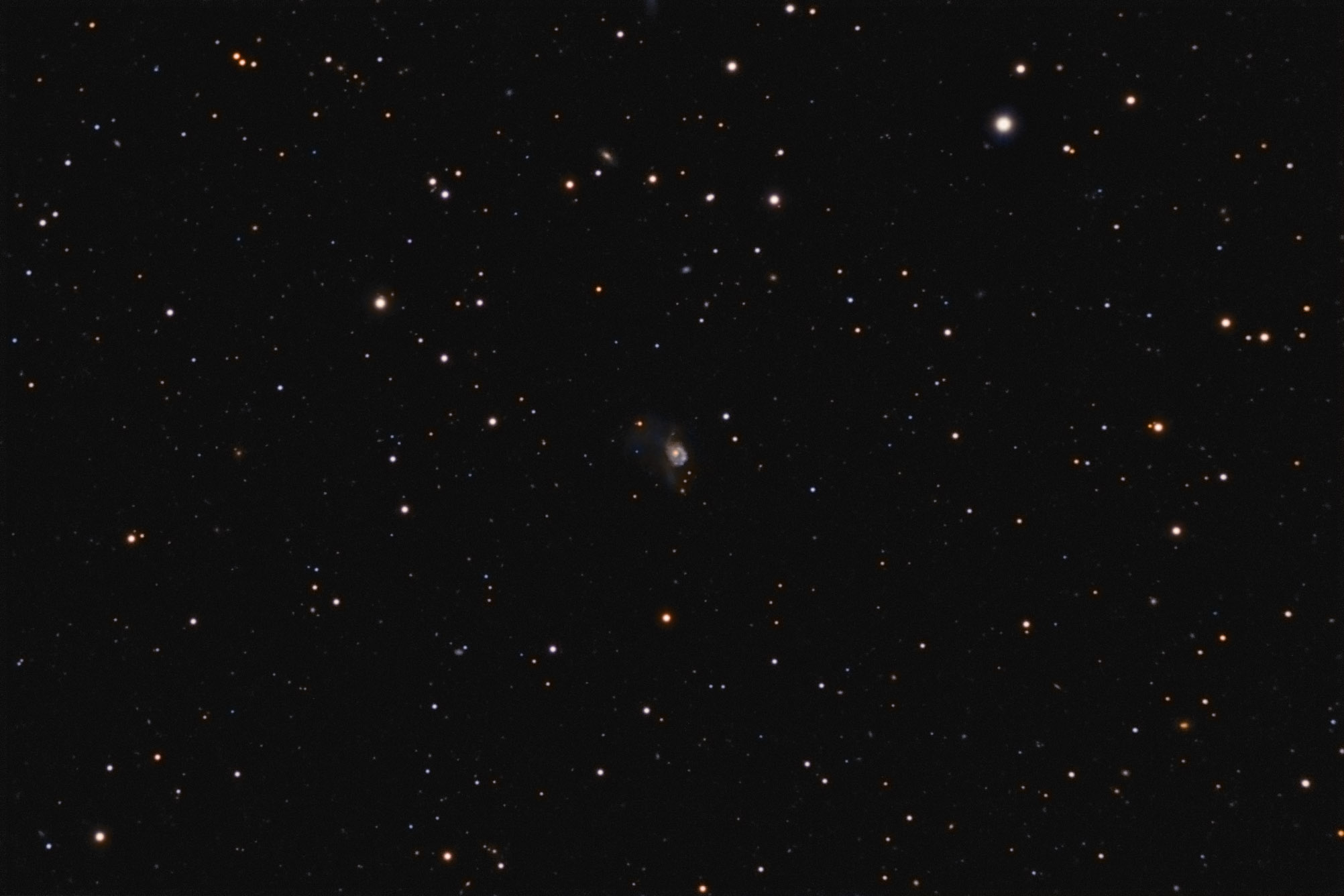
MRK231L4X10RGB2X10R.JPG
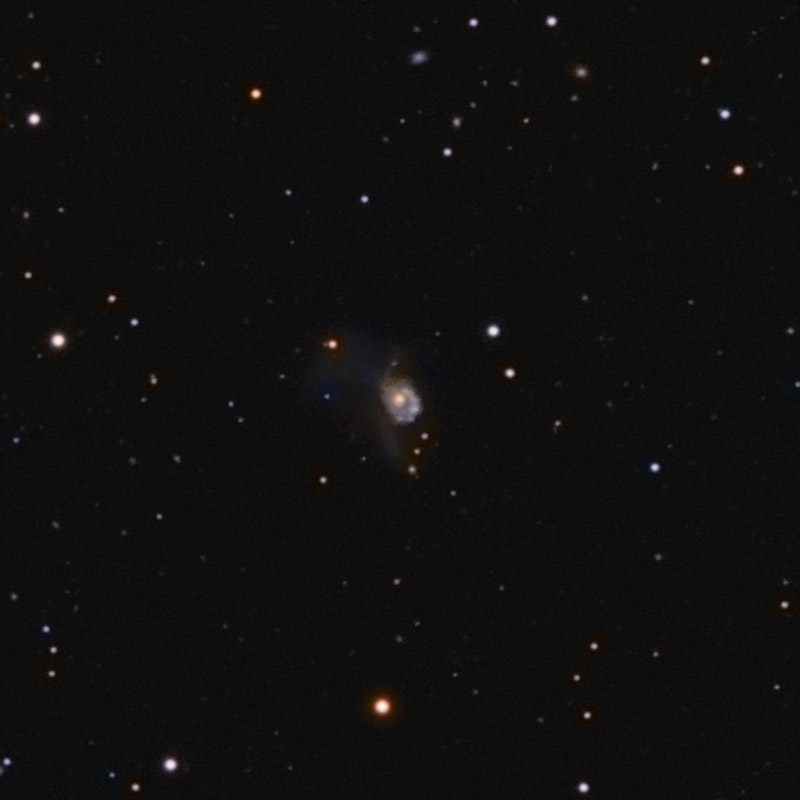
MRK231L4X10RGB2X10RCROP125.JPG
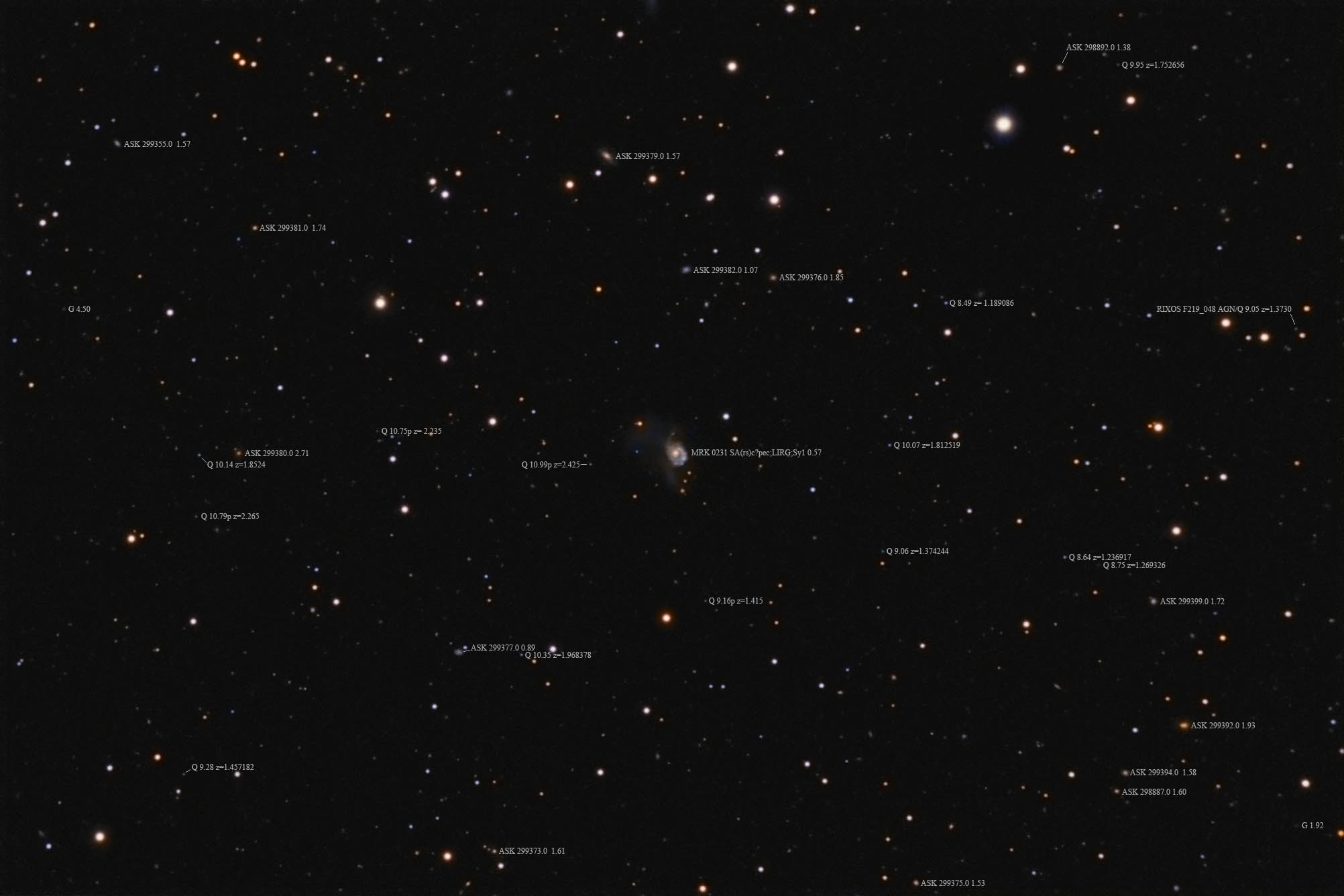
MRK231L4X10RGB2X10RID.JPG
|
Markaryan 273 is a well studied but mostly ignored by amateurs galactic merger in progress located in Ursa Major about 3 degrees northwest of M101. Redshift puts it about 516 million light-years distant. The core shows two nuclei one second apart. Far beyond my resolution this night. They consist of very different age stars. One of the merging galaxies is thought to have been unusually gas rich. A note at NED indicates there's a ring of star formation some 100 kpc (326,000 light-years) in diameter thanks to all the gas. I measure the southern plume as being some 144,000 light-years long though a note at NED puts it at 130,000. The difference may be due to the distance estimate used. As with all my redshift distances I used NED's 5 year WMAP calculator. I measure the northeastern fainter plume as being even longer at 165,000 light-years. Since they aren't 180 degrees apart I find the distance between their endpoints to be 103.7" of arc which works out to 259,000 light-years. The merging galaxies are considered very strong in all wavelengths from radio well into the ultraviolet. It is classed as an ultraviolet excess object, an IR source and a radio source. All but the gamma ray astronomers have put a lot of time into studying this object. There is a lot of information at NED on this galaxy, far too much for me to cover. Those interested can go to NED and look up MRK 273 and click on the notes link in the list of links at the upper right of the page. Several other galaxies with the same redshift as MRK 273 are in the area a few of which are in the frame.
I placed the galaxy well to the north of the center of the field to also pick up the core of the Abell 1783 galaxy cluster. This cluster's core consists of quite a few IC galaxies all of which are listed in NED as; "Identification as IC 0nnn is not certain." SEDS says of these; "Unidentified at the place given, or type unknown, in Ursa Major." Due to this, I've listed them with a question mark in the annotated image. The cluster's distance is about 920 million light-years. All the IC galaxies in this cluster were discovered in 1892 by Edward Barnard. He was a very careful observer so how these identifications became so questionable I don't know. With a radius of 35 minutes of arc MRK 273 is within the cluster but lies only about half as far away so the two are unrelated. All these IC galaxies were discovered by Edwin Barnard in June 1802. How such a careful observer came up with uncertain data I don't know. IC 936 may be a duplicate of IC 934 according to Seligman, if so what is the other one and which is the correct whatever IC number is used? It's all very confusing. Other IC galaxies credited to Barnard this night are just out of the image to the south. None of the identifications is certain, hence the question mark in the annotated image.
Well below MRK 0273 is the strange galaxy ASK 300802. Is that a plume going to the north-northeast or is it a separate galaxy? I consulted the Sloan image and couldn't tell. But according to NED, they say it is a star! Try as I may, I can't turn a fuzz patch into a star. So it is a mystery object, plume or separate galaxy but certainly not a star.
The frame contains several very blue star-like objects that appear to be quasars but aren't so listed at NED. Instead, they are listed as BLAGN (Broad Line Active Galactic Nuclei. Since they appear very quasar-like and are as bright as quasars I also show them as (Q?) in the annotated image. If a galaxy had a catalog designation that wasn't just its position I've shown that but if it is listed only by its coordinates I've just listed it as G followed by its distance. If a galaxy was in the IC but had no distance data it is listed with na where the distance would have been shown if it had been available. I've listed NED's classification of the object if given after its catalog name or "G" when available.
To show the faint northeastern plume of MRK 0273 I've stretched the image more than normal which also helps to show the noise in the image due to my short exposure time. I'd planned much more time but, as usual, this year, the weather conditions made that impossible. I had to fight for what little I got.
Also, the F7 star just east of MRK 273 sent horrid reflections all across the frame. The multitude of overlapping donuts it created was a major processing pain and cost me some faint detail. More time would have made those reflections even worse.
14" LX200R @ f/10, L=4x10' RGB=2x10', STL-11000XM, Paramount ME Related Designations for MRK273MRK 0273, UGC 08696, VV 851, Mrk 273, SBS 1342+561, I Zw 071, CGCG 271-060, CGCG 272-005, CGCG 1342.8+5608, CGPG 1342.8+5608, MCG +09-23-004, 2MASX J13444207+5553131, 2MASXi J1344420+555313, SDSS J134442.15+555313.8, SDSS J134442.16+555313.5, SDSS J134442.16+555313.6, IRAS 13428+5608, IRAS F13428+5608, AKARI J1344424+555316, ISOSS 058, ISOSS J13447+5553, LQAC 206+055 003, [RC2] A1342+56, ASK 300811.0, C-GOALS 22, NSA 052928, PGC 048711, UZC J134442.0+555312, 87GB 134253.6+560828, 87GB[BWE91] 1342+5608, [WB92] 1342+5608, NVSS J134442+555313, 6C B134252.4+560807, TXS 1342+561, GB6 J1344+5553, CXOMP J134442.0+555313, 2PBC J1344.2+5551, 2XMM J134442.1+555312, 2XMMp J134442.1+555312, 1AXG J134440+5553, [dML87] 678, [A2001] J134442.1+555313, [VCV2001] J134442.1+555313, [SLK2004] 0893, [RHM2006] ULIRGs 005, [VCV2006] J134442.1+555313, [FBS2007] 50, [HRT2007] J134444+555322, [JBB2007] J134442.12+555313.4 , [TCW2007] 149, [FCC2009] 009, [GMM2009] 0819603, [GMM2009b] 62, [TTL2012] 070237, [GMM2015] J134442.1+555313, [OYS2015] J206.17569+55.88711 , IC 0921, 2MASX J13430804+5539043, 2MASXi J1343080+553904, 2MASS J13430798+5539043, SDSS J134307.99+553904.3, SDSS J134308.00+553904.4, ASK 300906.0, LEDA 2509643, [BFW2006] J205.78325+55.65126 , Mr19:[BFW2006] 20347 NED02, Mr20:[BFW2006] 32589 NED03, [TTL2012] 081740, SDSS J134307.98+553904.5, IC 0926, 2MASX J13433923+5537534, 2MASXi J1343392+553753, 2MASS J13433925+5537535, SDSS J134339.26+553753.4, SDSS J134339.27+553753.5, GALEXASC J134339.06+553754.4 , SPIDER J205.91362+55.63152, [BFW2006] J205.91353+55.63157 , Mr20:[BFW2006] 32589 NED09, [TTL2012] 081741, SDSS J134339.24+553753.6, IC 0929, 2MASX J13434501+5538014, 2MASXi J1343450+553801, 2MASS J13434500+5538016, SDSS J134345.00+553801.8, SDSS J134345.01+553801.6, SDSS J134345.02+553801.6, ASK 300481.0, LEDA 2509027, [BFW2006] J205.93750+55.63384 , Mr20:[BFW2006] 32589 NED10, [GMM2009] 0817896, [TTL2012] 090687, IC 0930, 2MASX J13434549+5538474, 2MASXi J1343454+553846, 2MASS J13434553+5538473, SDSS J134345.54+553847.4, SDSS J134345.55+553847.4, SDSS J134345.55+553847.5, GALEXASC J134345.58+553848.1 , ASK 300910.0, [BFW2006] J205.93971+55.64657 , Mr20:[BFW2006] 32589 NED11, [TTL2012] 081744, SDSS J134345.53+553847.6, IC 0932, 2MASX J13435116+5538483, 2MASXi J1343511+553848, 2MASS J13435121+5538483, SDSS J134351.23+553848.5, GALEXASC J134351.79+553848.9 , LEDA 2509480, IC 0934, IC 0935, 2MASX J13435235+5539243, 2MASXi J1343523+553924, 2MASS J13435239+5539245, SDSS J134352.38+553924.5, SDSS J134352.39+553924.5, ASK 300441.0, [BFW2006] J205.96822+55.65687 , Mr20:[BFW2006] 32589 NED15, [TTL2012] 082501, SDSS J134352.37+553924.7, IC 0936, 2MASS J13440853+5542221, SDSS J134408.54+554221.9, SDSS J134408.55+554221.9, SDSS J134408.55+554222.0, GALEXASC J134408.51+554221.6 , ASK 301120.0, MAPS-NGP O_134_0024335, LEDA 2511548, [BFW2006] J206.03557+55.70616 , Mr20:[BFW2006] 32589 NED16, [TTL2012] 070297, SDSS J134408.53+554222.1, IC 0937, 2MASX J13442896+5537482, 2MASXi J1344289+553748, 2MASS J13442892+5537486, SDSS J134428.92+553748.6, SDSS J134428.92+553748.7, SDSS J134428.93+553748.7, ASK 300446.0, [BFW2006] J206.12045+55.63025 , Mr20:[BFW2006] 32589 NED17, [WLH2009] 0695 NED01, [TTL2012] 085651, SDSS J134428.90+553748.9, NGC 0507, UGC 00938, ARP 229 NED01, VV 207a, CGCG 502-067, CGCG 0120.8+3300, MCG +05-04-044, B2 0120+33, 2MASX J01233995+3315222, 2MASS J01233993+3315218, SDSS J012339.90+331519.2, GALEX J012340.03+331523.0, GALEX J012340.1+331522, GALEXASC J012339.79+331521.8 , WBL 038-015, LDCE 0074 NED071, HDCE 0070 NED021, USGC U059 NED36, NSA 129359, PGC 005098, SSTSL2 J012339.87+331522.2, UZC J012340.1+331520, [WB92] 0120+3257, 6C B012050.2+325930, 6C* 0120+329, RX J0123.6+3315, 1RXS J012337.2+331508, 2XMM J012339.9+331521, 2XMMp J012339.9+331521, 1XMM J012339.9+331521, LGG 026:[G93] 004, [SLH97] H01064, [BDG98] J012340.0+331520, RX J0123.6+3315:[BEV98] 002, RX J0123.6+3315:[CAE99], [MLO2002] J012340.0+331520, B2 0120+30:[MLO2002] NED45, NGC 0507:[PFP2003] 10, [FPK2009] 93747, NGC 0507 GROUP:[ZAC2011] BCG , RSCG 08:[WBJ2013] A, ABELL 1783, ZwCl 1341.9+5550, MCXC J1343.7+5538, SCL 133 NED02, RIXOS F254_524, RX J1343.7+5538, RX J134334.1+553644, [YSS2008] 045, MRK273, IC0921, IC926, IC929, IC930, ID931, IC932, IC934, IC936, IC937, UC938, ABELL1783, SAFIRES J134442.25+555314.1, | 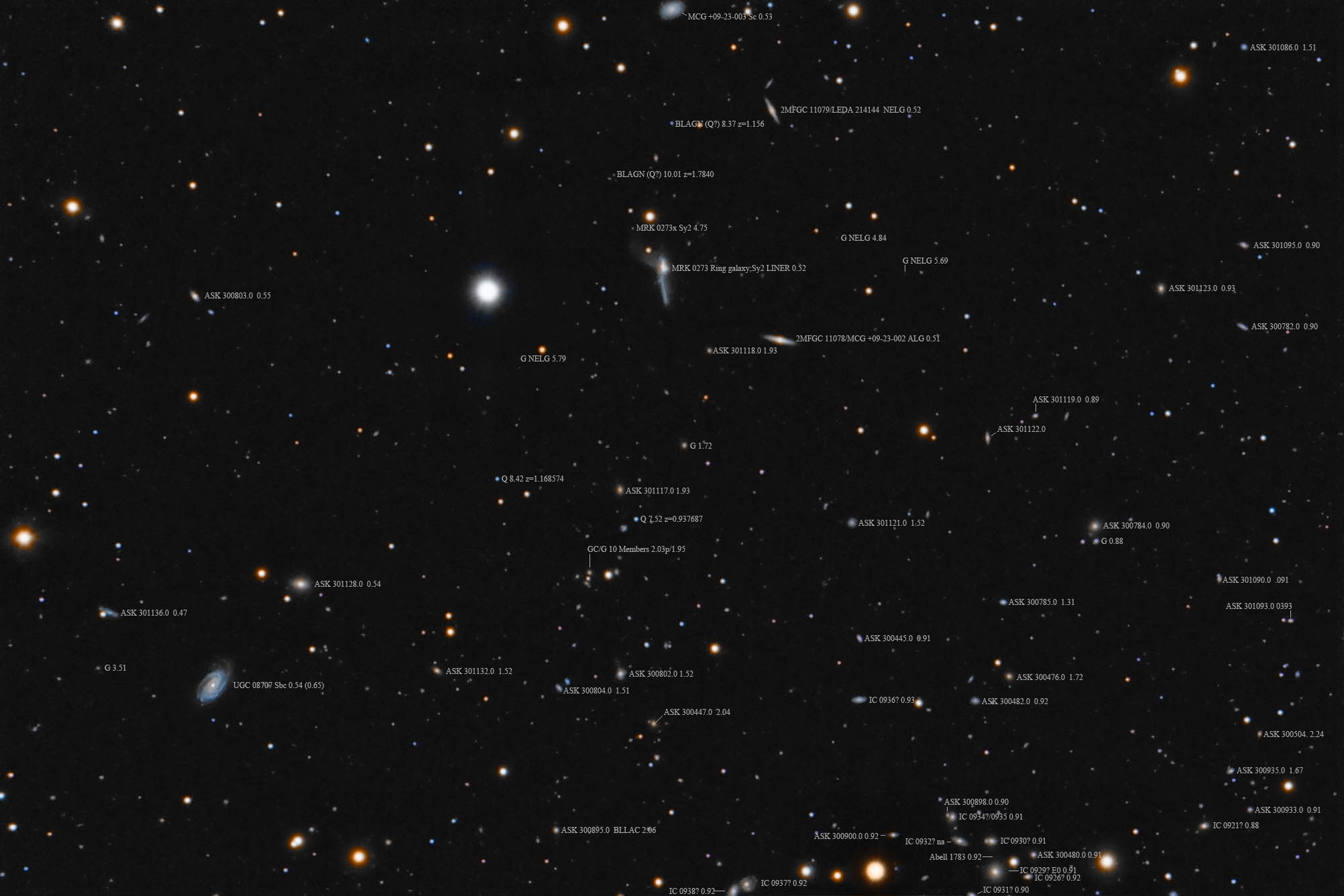
MRK273L4X10RGB2X10IDR.JPG
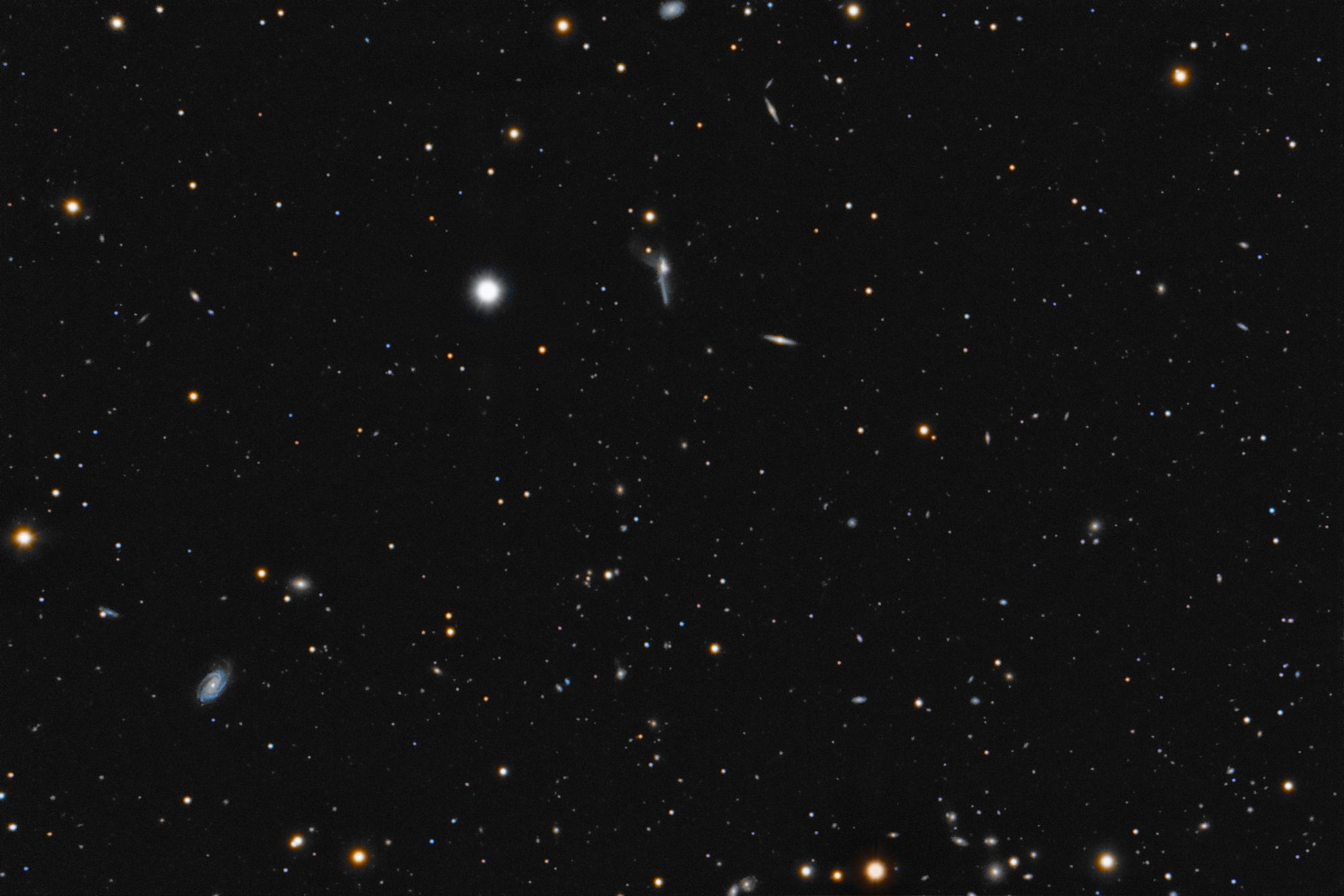
MRK273L4X10RGB2X10R.JPG
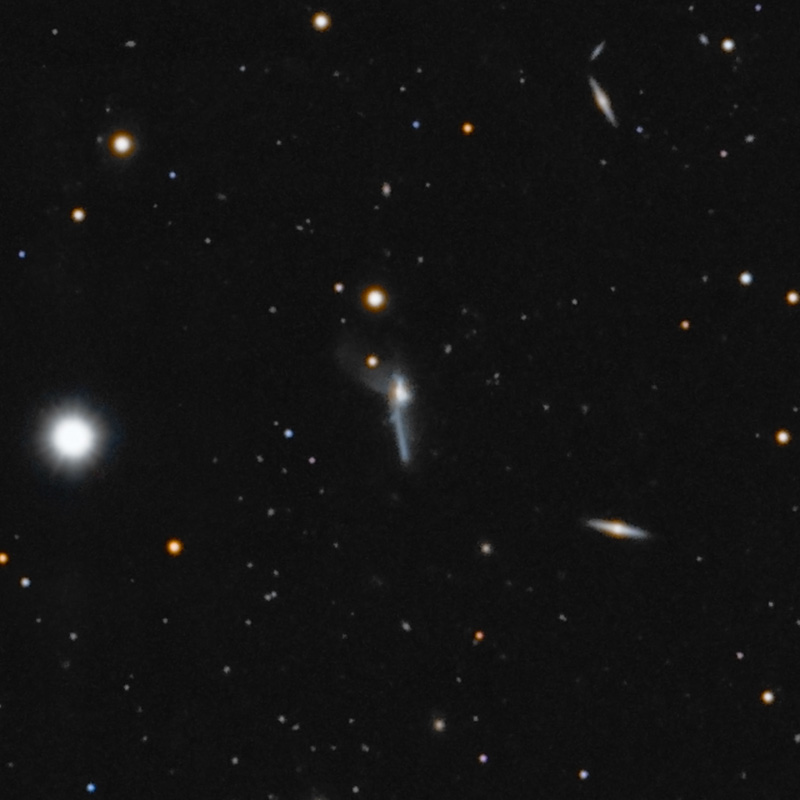
MRK273L4X10RGB2X10RCROP150.JPG
|
Taken 6-5-16 at about 5 hours UTC.
Normally I don't take main belt asteroids, only near earth ones as they pass by but I made an exception here. I doubt many have heard of Nagin Cox, but you should have. The naming citation for the asteroid named for her gives only part of the story. Here that is:
"(14061) Nagincox = 1996 CT7
Nagin Cox (b. 1965) is a system engineer and a manager on multiple interplanetary robotic NASA missions, including Galileo, the Mars Exploration Rover and the Kepler telescope, which searches for earth-like planets around other stars. She is currently on the mission operations team for Mars Curiosity Rover."
She has been brought in to solve why a mission failed or rescue one in trouble. She much prefers to prevent problems before they occur. If you ever get a chance to hear her speak on the subject I highly recommend you attend. You will learn a lot about both screw-ups and successes. She's a very entertaining and instructive speaker. She also goes into rather dangerous (for a woman) countries at the behest of the state department to speak on woman's education, something that can be quite dangerous to promote in the places she's been. Thus her efforts at science education and women's education make her very deserving of an asteroid, I just wish it could have been a brighter one as she's earned it.
Trying to get this image was a major struggle. When I was told she had no image of her asteroid and was asked by a friend of hers to get one I'd just had a perfect night (one of only a couple all year) the night before the request. After that nothing but clouds. A sucker hole opened on June 5 (UT) long enough to get 30 minutes of luminance data. The asteroid had just started retrograde motion so was moving slowly. Too slow to show much motion in 30 minutes. It's moving faster now but is lost to the trees from my location until next year. Nearly a month after getting the luminance data I was able to use sucker holes on various nights to get fairly good red and green frames (one each) of the star field the asteroid was in. Being very low by now and working between trees I finally got a blue frame but it was through a strong haze and very weak. Bringing it up to match the others added a ton of noise. To get better blue I did pixel math to create a pseudo blue based partly on the blue I did get and extending the difference between the red and green frames. The result is fairly good for the star field. It was balanced by using NOMAD data and eXcalibrator. I think it fairly accurate. Doesn't help it was in Scorpio a constellation too low for me to work in at my 47 degrees north except on perfect nights.
Turned out there were three other asteroids nearby though they are fainter. The annotated image details them but I don't put much confidence in the Minor Planet Center's magnitude estimates for the two nearest Nagincox. One seems to be brighter than its prediction while the other much fainter. Certainly, they differ by far more than the 0.2 magnitude difference the center predicted. I think her asteroid's magnitude estimate is reasonable as is the other one.
Out of curiosity, I looked up the distances to the asteroids at the time the image was taken. Turns out Nagincox was much further from the earth and the sun than the others. Here's the breakdown in AU with distance from the earth listed first followed by its solar distance. One AU is just under 150 million kilometers (the mean distance the earth is from the sun) or a bit under 93 million miles for the metrically challenged.
(14061) Nagincox 1.705 2.707
(426381) 2013 PG16 0.920 1.925
(112709) 2002 PW109 1.068 2.072
(113050) 2002 RR52 0.971 1.975
14" LX200R @ f/10, L=3x10' RGB=1x10', STL-11000XM, Paramount ME Related Designations for NAGINCOXNAGINCOX, | 
NAGINCOXL3X10RGB1X10R.JPG
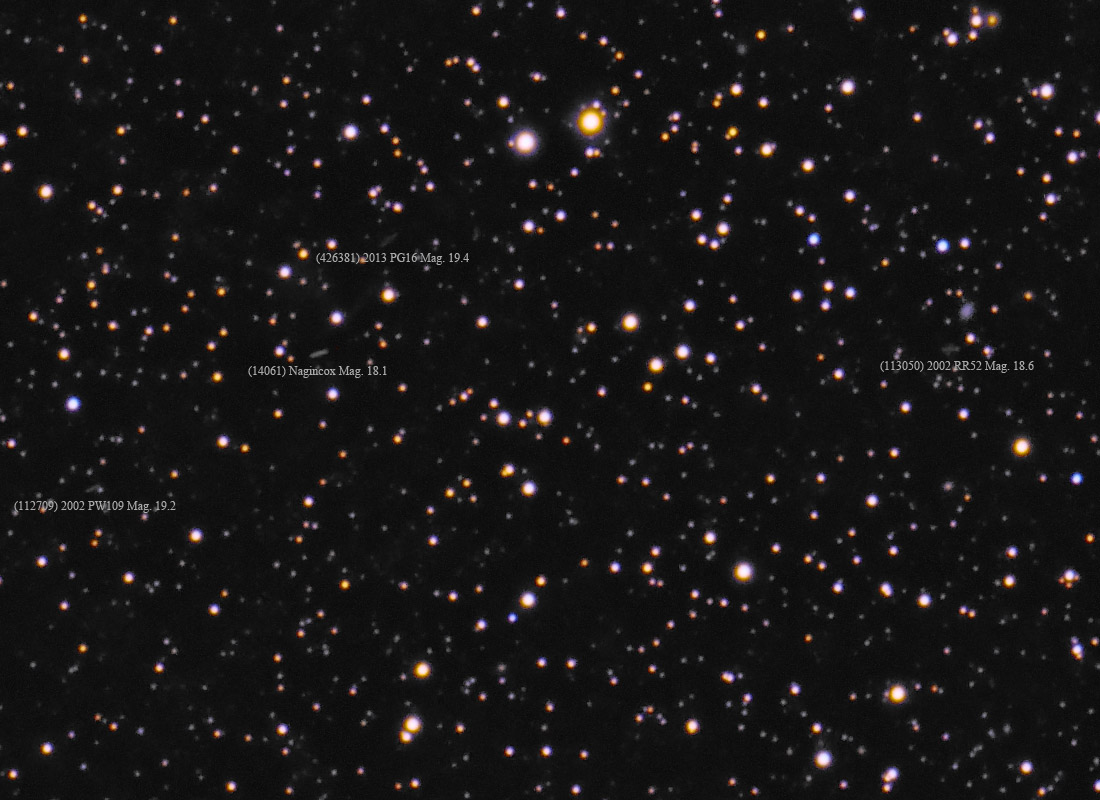
NAGINCOXL3X10RGB1X10RID-CROP.JPG
|
Name HW Object is part of the Herbig-Haro object HH 168. It is a bubble in the Cepheus A star-forming cloud about 2300 light-years distant. It is located just south of the Cave Nebula, Sh-155. In fact, I first noticed it in some wide angle shots of that nebula as a small blip. I put the coordinates into SIMBAD and it came back with the very odd designation of Name HW Object. A bit of digging and I find "NAME" is their way of saying "Commonly known as" and in fact, most literature refers to it as Object HW. Technically that designation appears to apply to only a small condensation in HH 168. At least that's what Figures 2 and 3 at http://adsabs.harvard.edu/full/1985ApJS...59..383H indicates (see plates at the end of the article -- after the footnotes). This is an old 1985 article.
HH-168, as it is known today, is a fairly large feature consisting of an area with lots of knots and young stars to the west with a strong outflow jet going to the east. HW is apparently just a tiny part of this object. South of it is an oddly colored reflection nebula and another open rectangular shaped reflection nebula lies to the north. The dark area of the latter is likely a Bok globule. SIMBAD shows this field jam-packed with young stellar objects. The dust hides an infrared star cluster as well. I found no designation for either of the reflection nebulae on either side of HH 168 nor any other nebula in the field but for the rather bright reflection nebula near the bottom left of the image. That is GN 22.55.2. I would assume it too is an illuminated part of the same cloud the other reflection nebula is involved with. While SIMBAD lists HH 168 A through G all are listed as stars rather than nebulae so I didn't bother to annotate them. That left HH 174 as the only other HH object in the image. It is a very small faint smudge on my image.
It turns out HH 168 is a very well studied object. Hubble, Chandra and Spitzer have all given it their attention. Listed below are the three papers from these scopes. The HST paper is quite readable and very interesting. I'll save my fingers and just suggest those interested go to the link. The Chandra and Spitzer links add some to the picture.
HST (visible light): http://iopscience.iop.org/article/10.1086/301522/pdf
Chandra (X-ray): http://cds.aanda.org/articles/aa/pdf/2009/47/aa12890-09.pdf
Spitzer (IR) http://iopscience.iop.org/article/10.1088/2041-8205/726/1/L1/pdf
I found nothing of interest on the other objects in the image.
Again the weather did a number on this data. All frames were hit by clouds. While the color of the reflection nebulae is odd it is very close to what I see on the wide-angle images of the Cave Nebula that include them so think I compensated fairly well for the weather. Just that the image doesn't go as deep as it would have without the clouds. The background is rather noisy due to this thin data.
14" LX200R @ f/10, L=4x10' RGB=2x10', STL-11000XM, Paramount ME | 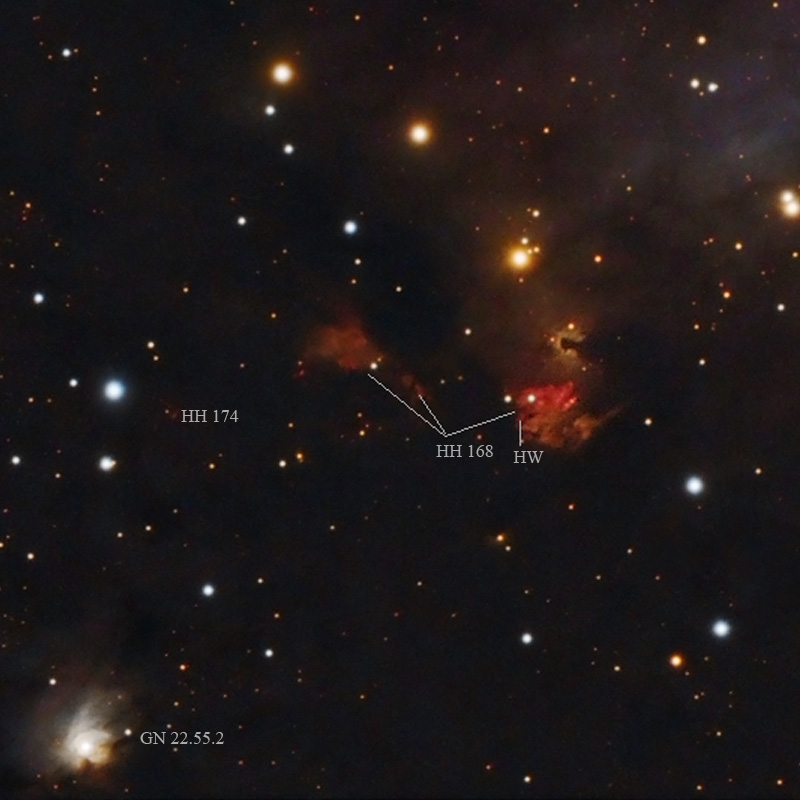
NAME_HW_OBJECTL4X10RGB2X10-ID.JPG
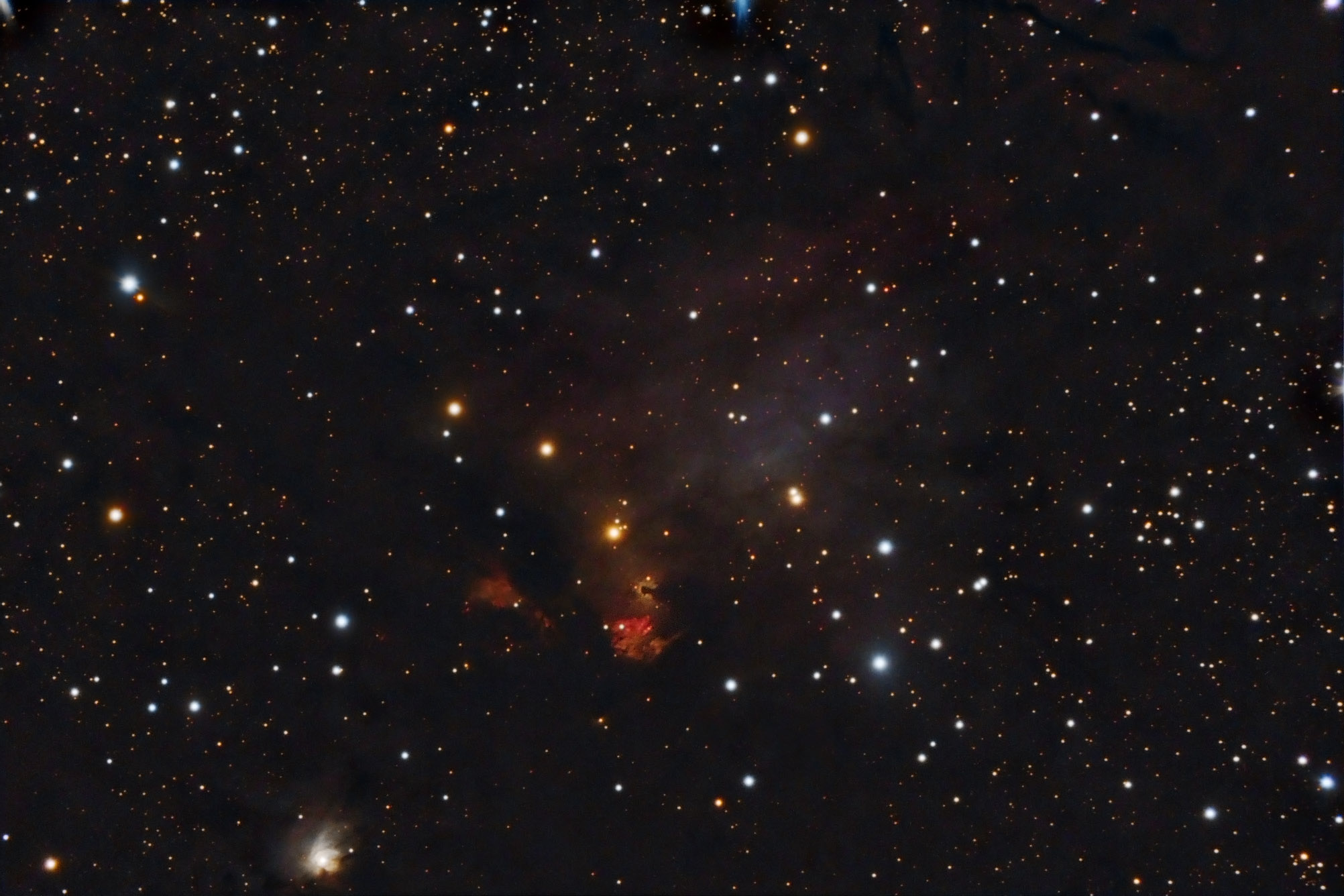
NAME_HW_OBJECTL4X10RGB2X10.JPG
|
This is a rather newly discovered (2005) planetary nebula in Sagitta. I only learned of it a few months ago and put it on the top of the to-do list though it didn't seem like a target for my small system. I'm breaking with my FIFO rule of processing (oldest processed first) with this post and processing newest first (LIFO for the accountants out there). It was taken on July 26, 2011. About the only clear, moonless night all July and so far in August. I'm breaking my rule since yesterday the Hubble Space Telescope folks released their image of the object. They beat me to it as they imaged it July 2, 24 days ahead of me. They beat me on resolution too but considering I saved more than billions of dollars putting my system together I can live with that. Since they give an explanation of this object that covers about all that is known about it I'll save my fingers and give you the link:
http://hubblesite.org/images/news/release/2011-24
Their image used narrowband filters to pick up features I couldn't using only wideband filters. At 15,000 light-years, this one is a very distant planetary somewhat obscured by the dust and gas of our galaxy. Hubble's image is rotated 90 degrees clockwise from mine.
It is located near a dense region of our Milky Way so the field is full of stars which causes the image size to be quite large. No way I can compress the image to the size I normally do. So this one will take some time to load for you dial-up users out there. Sharp-eyed viewers may notice what appears to be a galaxy well east and a bit north of The Necklace. Neither NED nor SIMBAD show anything at this location. It is seen on the POSS plates however so is real. Likely it is a heavily obscured anonymous galaxy. If by chance anyone knows of this object please let me know (never happens but I keep asking anyway).
The full image is at my normal 1" per pixel. The cropped image at 0.5" per pixel.
14" LX200R @ f/10, L=4x10 RGB=2x10, STL-11000XM, Paramount ME Related Designations for NECKLACENECKLACE, | 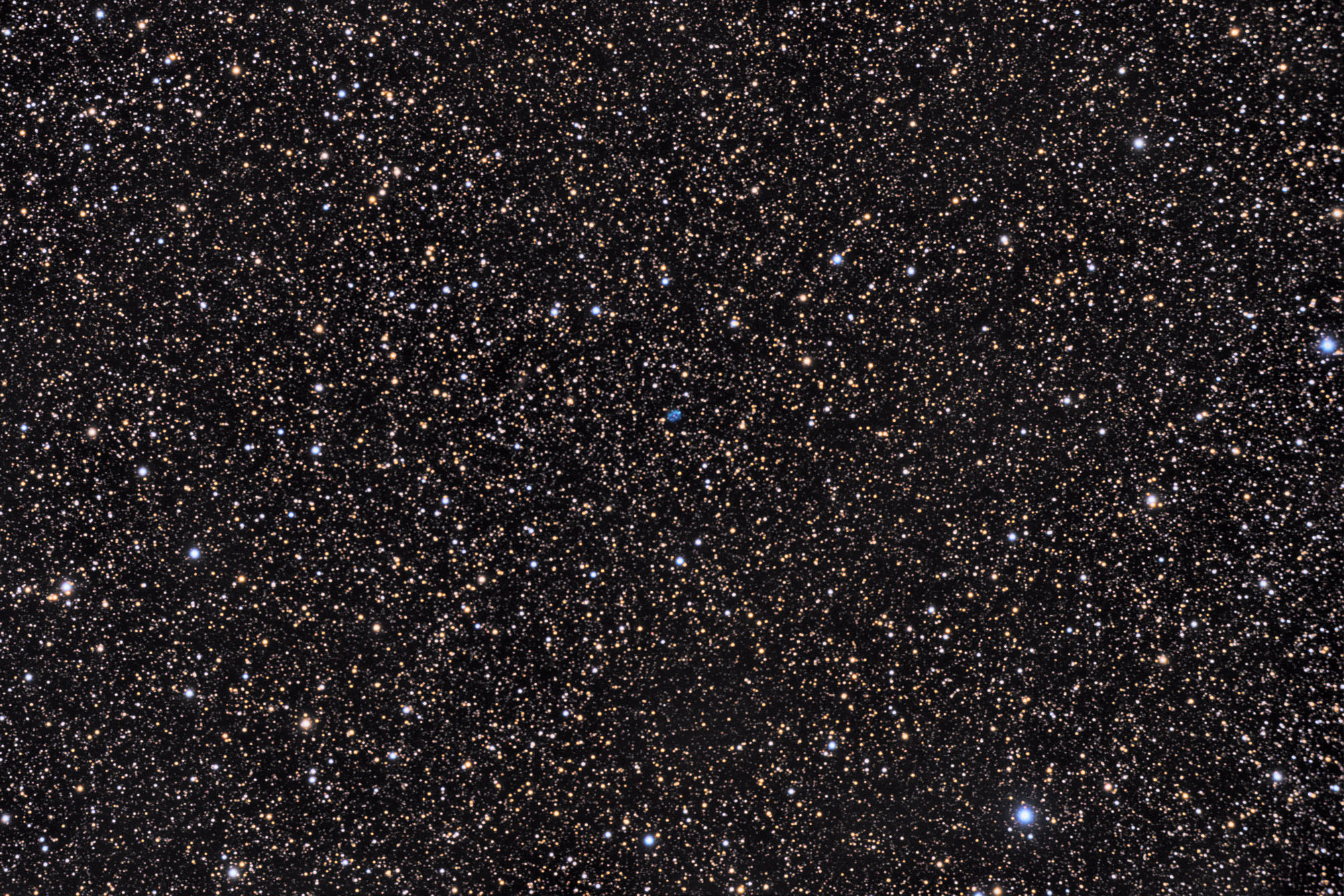
NECKLACE_L4X10RGB2X10.JPG

NECKLACE_L4X10RGB2X10CROP200.jpg
|
NGC 23 and NGC 26 are a pair of galaxies about 195 million light-years distant in the constellation of Pegasus about three degrees south of Alpheratz. NGC 23, the northwestern member, is classed by NED as SB(s)a; HII;LIRGSbrst while the NGC project says simply SB(s)a. HII means it has rather strong H alpha emission. This can be seen in the HST image at: http://commons.wikimedia.org/wiki/File:NGC23-hst-110-160-190.jpg which shows just the very core of the galaxy out less than 10" of arc. LIRGSbrst means it is a luminous infrared galaxy with starburst activity. This too is found in a region less than 10" from the galaxy's core. In any case, the galaxy appears somewhat disturbed so has likely interacted with some other galaxy, possibly NGC 26 10 minutes to the southeast which also appears disturbed. It is very non-symmetrical both as to the barred region which is much more organized to the north than to the south and the outer arms. The southern bar region seems to consist mostly of two bright star clouds. Off of each end are two the two faint arms. The one coming off the northern end and running down the western side is much brighter and condensed than the one coming off the disorganize southern end. The latter extends faintly well to the north more as a tidal plume than a spiral arm.
NGC 26 is classed by NED and the NGC project as SA(rs)ab. While a simple classification its structure is odd. Coming off the core on the eastern side is a bright arm arc that quickly ends. There seems to be no similar arm on the western side though one is hinted at in the DSS IR image. This is surrounded by a lopsided ring of rather white stars. Outside this is an arc of blue stars that circles about two thirds of the way around becoming a narrow dark lane to the south. Outside of these are faint spiral arms, the eastern one being very large and much brighter than the smaller western one. It is as if something pulled the entire structure but for the core to the east, the less dense the structure the more it was pulled off center. One very old paper indicated this might be due to a dwarf galaxy it ate sometime in the past.
NGC 23 was discovered by William Herschel on September 10, 1784. It is in the second Herschel 400 observing program. Unfortunately, my log from that was lost in the move to Minnesota. NGC 26 was found by Heinrich d'Arrest on September 14, 1865. Apparently, it was just a hair too faint for Herschel's speculum mirror telescope.
While there are many other galaxies in the image NED had little on them, not even a magnitude in most cases. Due to the lack of information, I didn't prepare an annotated image. Sure looks like it would have been interesting if the data had been available.
This is another field suggested to me by Sakib Rasool.
14" LX200R @ f/10, L=4x10' RGB=2x10' STL-11000XM, Paramount ME Related Designations for NGC0023NGC 0023, UGC 00089, MRK 0545, KUG 0007+256, CGCG 477-062, CGCG 478-034, CGCG 0007.3+2539, MCG +04-01-033, 2MASX J00095341+2555254, 2MASS J00095340+2555259, SDSS J000953.42+255525.6, GALEXASC J000953.40+255524.9 , GALEXMSC J000953.45+255523.4 , IRAS 00073+2538, IRAS F00073+2538, AKARI J0009533+255529, NSA 126309, PGC 000698, SSTSL2 J000953.37+255526.2, UZC J000953.4+255526, UZC-BGP 02A, 87GB 000717.6+253820, 87GB[BWE91] 0007+2538, NVSS J000953+255526, ALFALFA 4-220, GB6 J0009+2555, LGG 002:[G93] 003, [M98j] 001 NED01, [BTW2003] J0010+2557, [RHM2006] LIRGs 020, NGC 0026, UGC 00094, KUG 0007+255, CGCG 477-064, CGCG 478-036, CGCG 0007.8+2533, MCG +04-01-034, 2MASX J00102587+2549544, 2MASS J00102586+2549549, IRAS 00078+2533, IRAS F00078+2533, NSA 126323, PGC 000732, UZC J001025.8+254955, UZC-BGP 02B, NVSS J001025+254957, ALFALFA 4-221, LGG 002:[G93] 004, [M98j] 001 NED02, NGC0023, NGC0026, | 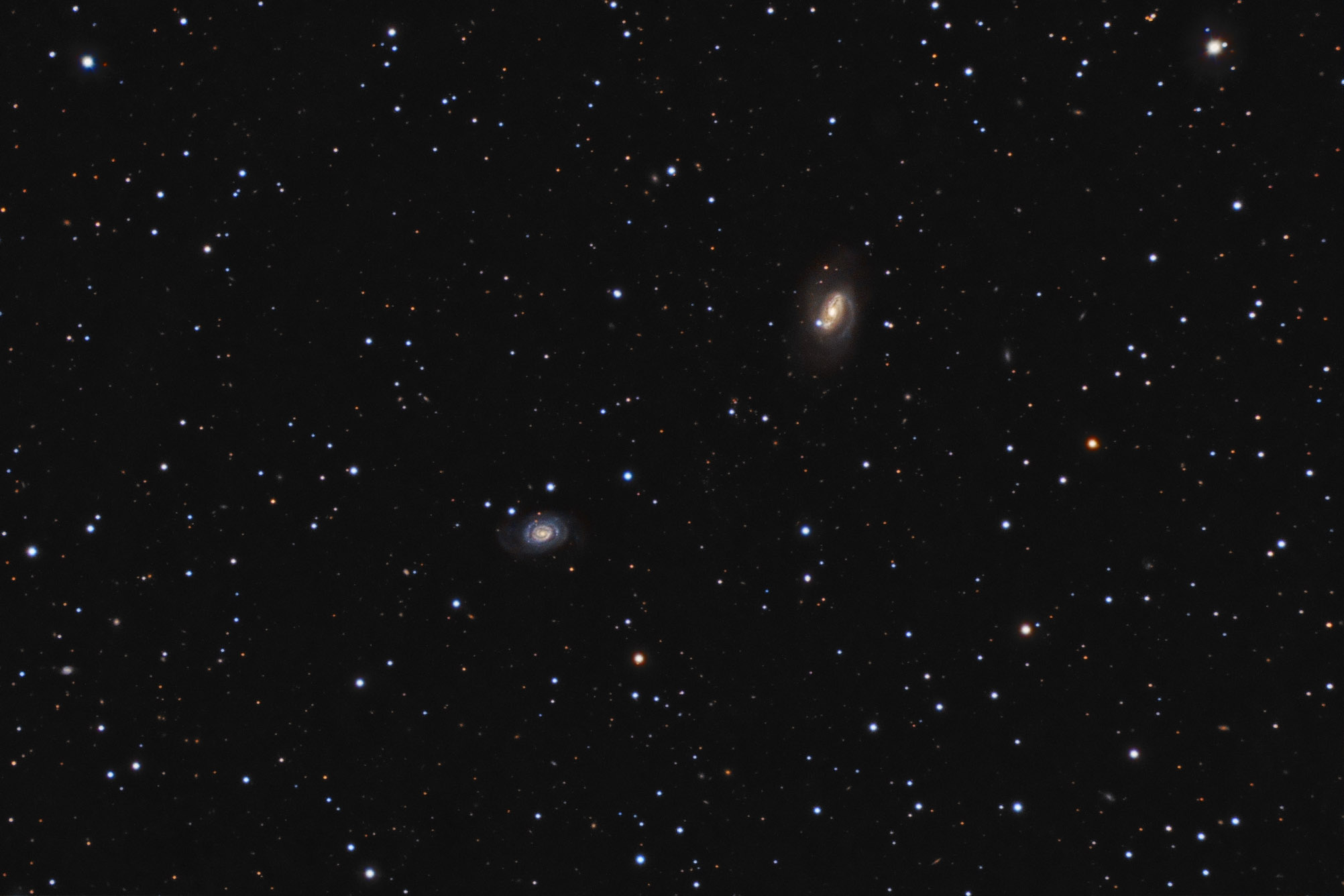
NGC0023-0026L4X10RGB2X10.JPG
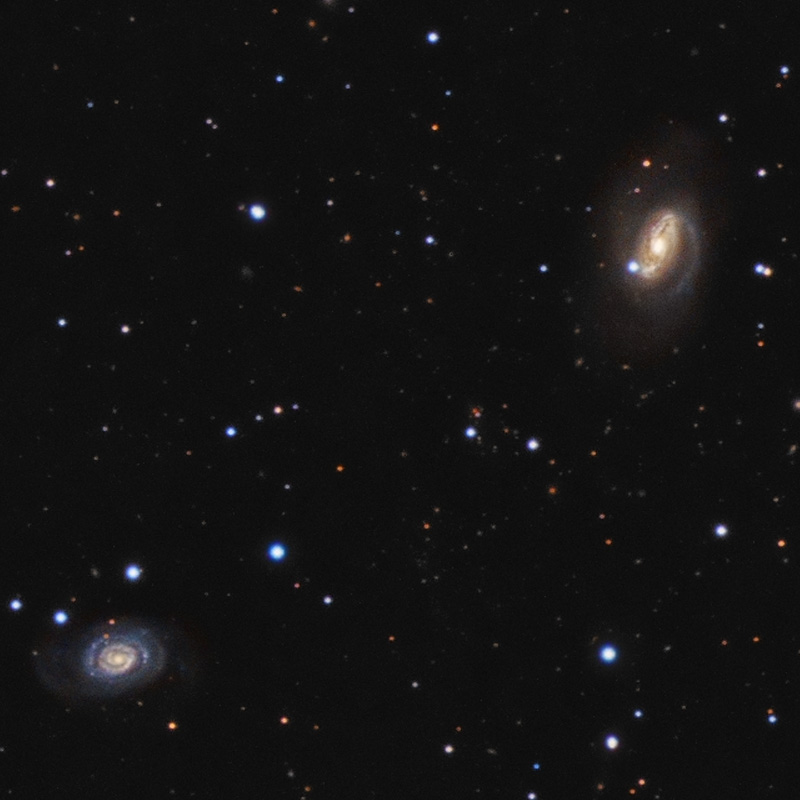
NGC0023-0026L4X10RGB2X10CROP125.JPG
|
KPG 3 is a pair of galaxies in Andromeda about a half degree east of Alpheratz a bit over 310 to 340 million light-years distant. The eastern member is NGC 27 a spiral galaxy that NED and the NGC Project classifies as S? while Seligman says Sbc?. I measure its size at nearly 120,000 light-years counting faint extensions seen in the FITs data and 90,000 for the bright region obvious in the JPG image. It was discovered by Lewis Swift on August 3, 1884. The companion was too faint to be seen in his telescope so was missed.
The companion is UGC 95, an edge on spiral. It qualifies as a flat galaxy and is FGC 16. NED lists it as being an Sc galaxy. Most distance measurements put it about 30 million light-years further than NGC 27. With that difference and lack of any distortion to either it is likely they are not interacting and thus close as seen only from our perspective. It is a very large spiral which I measure at about 190,000 light-years.
The other major galaxy in my image is UGC 105 which NED classifies as (R')SAB(S)0 and Seligman as (R')SAB0^+(s). It is an obvious ring galaxy with a very blue ring around a barred core. Redshift puts it at about the same distance as UGC 95, 350 million light-years. The ring is off center from the barred core extending further northeast than southwest. I measure the size of the galaxy at about 125,000 light-years.
Only two other galaxies in the image have redshift data. PGC 786 as an Sb spiral and LEDA 1856846 is an edge on disk galaxy not classified by NED. Both are about 350 million light-years distant same as UGC 105. I measure them at 83,000 and 54,000 light-years across respectively.
Several other PGC galaxies are in the image and are labeled but have no classification or redshift data.
14" LX200R @ f/10, L=4x10 RGB=2x10, STL-11000XM, Paramount ME Related Designations for NGC0027NGC 0027, UGC 00096, CGCG 499-063, CGCG 0007.9+2844, MCG +05-01-044, 2MASX J00103277+2859464, 2MASS J00103276+2859463, 2MASS J00103293+2859456, IRAS 00079+2843, IRAS F00079+2842, ISOSS J00104+2858, KPG 003B, LDCE 0012 NED001, MAPS-PP O_1257_0271300, NSA 126326, PGC 000742, UZC J001032.9+285946, NVSS J001032+285941, [SLK2004] 0017, KPG 003, NGC0027, KPG3, | 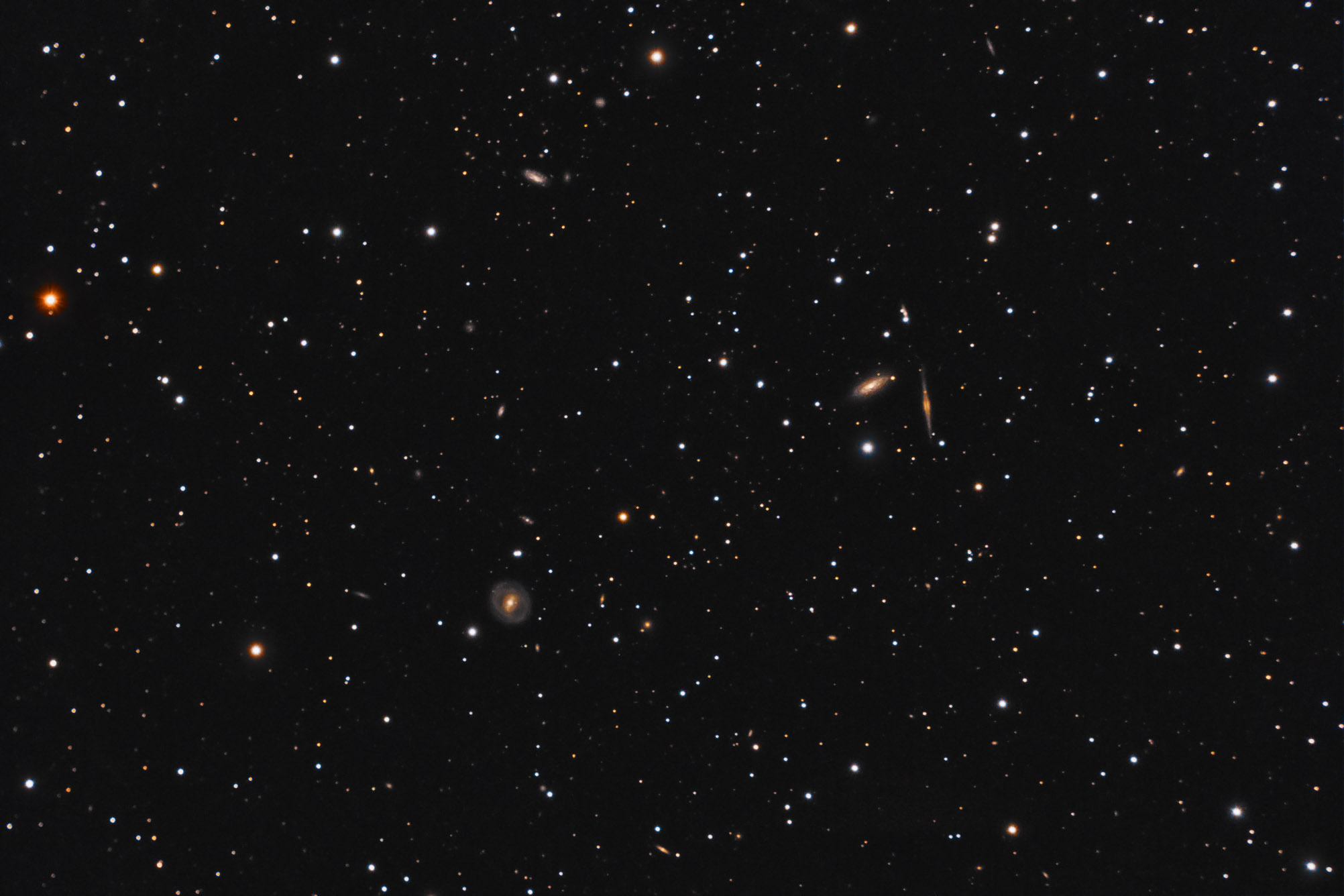
NGC27L4X10RGB2X10.JPG
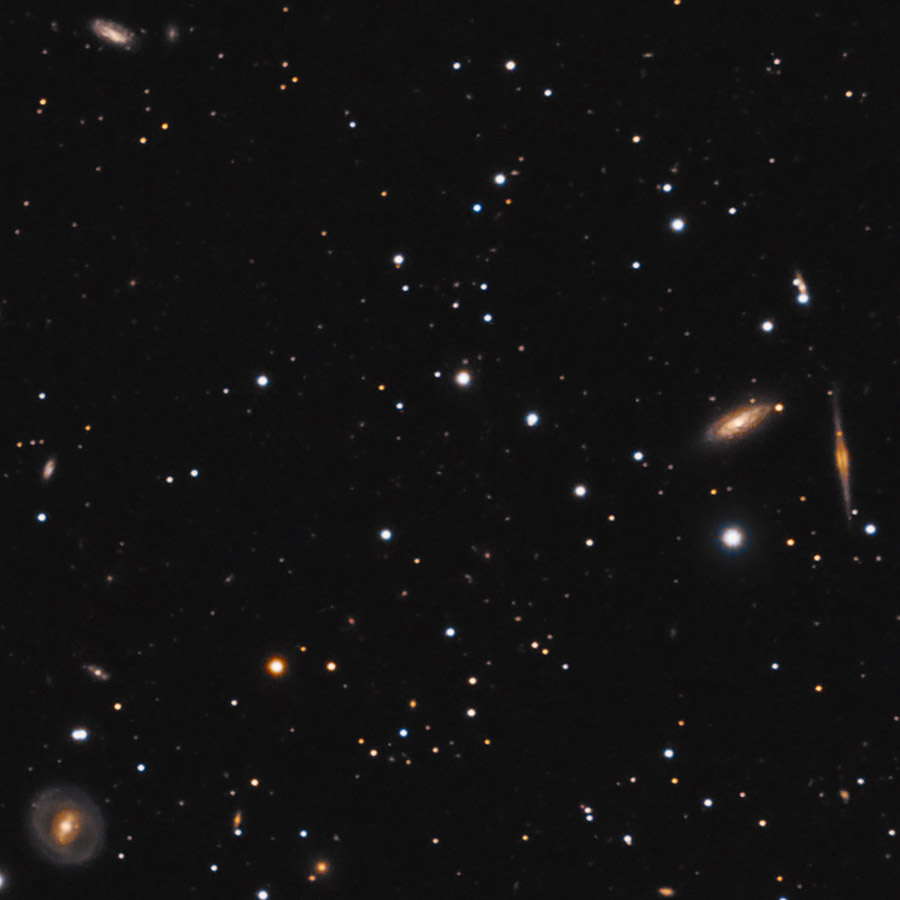
NGC27L4X10RGB2X10CROP125.JPG
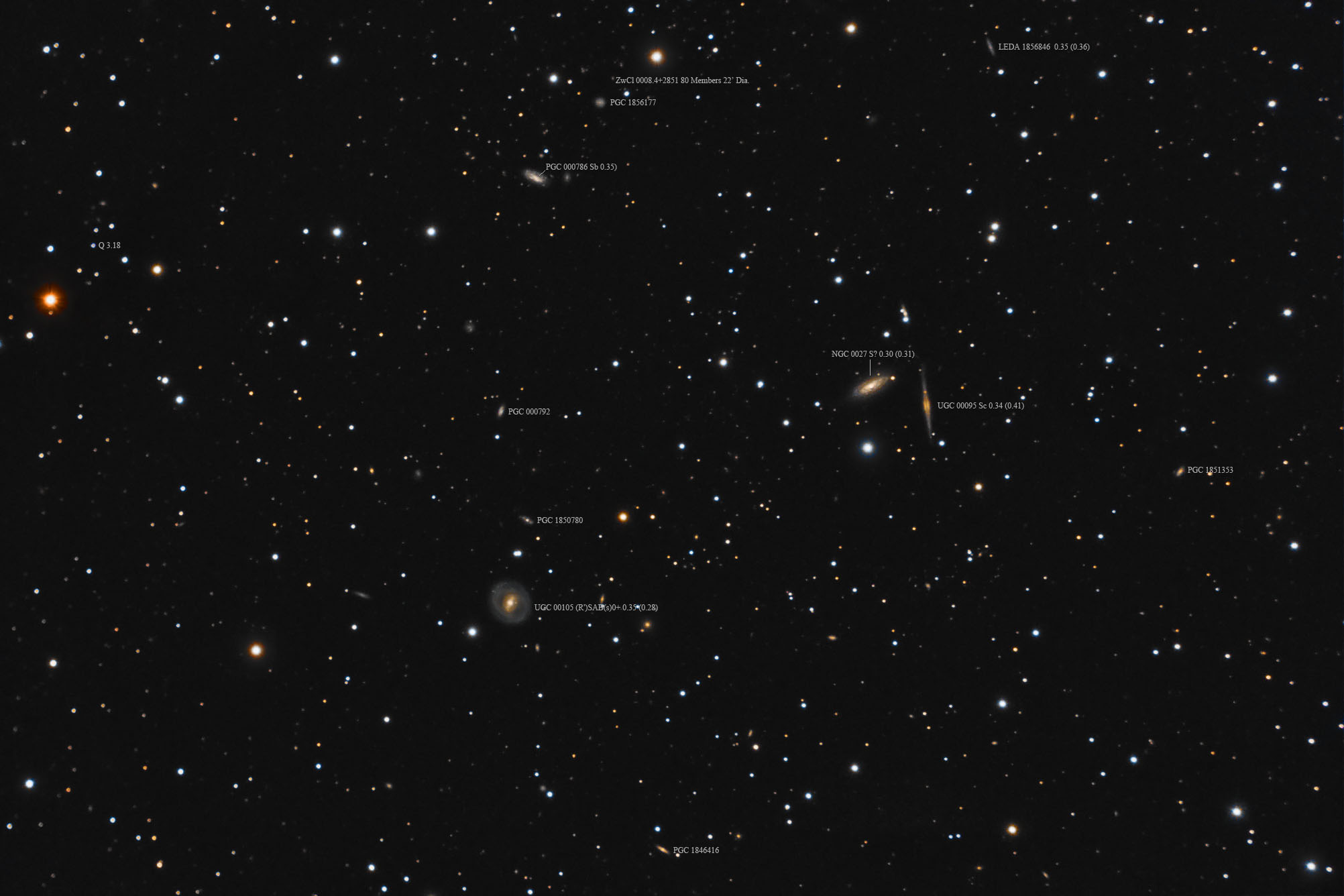
NGC27L4X10RGB2X10ID.JPG
|
























